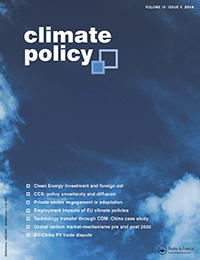This paper assesses the potential for improving the CO2 intensity of Japan’s electricity sector—the units of carbon dioxide emitted per units of electricity generated—by examining the potential for the feasibility of restarting nuclear power plants and increasing renewable electricity generation by 2030. The analysis shows that, utilizing these two...
- Clear all
- Publication Year: (-) 2015
- Topic: (-) International Climate Regime
- Topic: (-) Sustainable Technology
- Region/Country: (-) Asia
- Region/Country: (-) United Republic of Tanzania
Results 1 - 10 of 27 (Sorted by date)
On 17 July 2015, the Japanese government unveiled its Intended Nationally Determined Contribution (INDC) to reduce its greenhouse gas (GHG) emissions by 26% below FY 2013 levels by FY 2030 (25.4% reduction below FY 2005 levels). The government also approved the outlook for long-term energy supply and demand, which stipulates that in 2030 the share...
In Climate Policy
This article assesses Japan’s carbon budgets up to 2100 in the global efforts to achieve the 2 8C target under different effortsharing approaches based on long-term GHG mitigation scenarios published in 13 studies. The article also presents exemplary emission trajectories for Japan to stay within the calculated budget. The literature data allow for...
This study conducted a comparative assessment of 48 greenhouse gas (GHG) emissions reduction scenarios for 2030 reported in seven studies published since 2011 and based on bottom-up energy system analyses. This study conducted two sets of analyses. First, the scenarios were categorized into four mitigation effort levels and assessed the value...
<要旨> 本稿では、現在公表されている18 GWにおよぶ石炭火力発電の新規建設及び更新(以下、設備追加)計画が日本の温暖化対策に関する中期目標(2030年目標)及び長期目標(2050年目標)に与える影響について分析した。加えて、これらの目標の達成に向けて電力業界全体の実効性のある取組が講じられた際の、石炭火力発電設備に対する経済的リスクについて考察した。 中期目標(2030年目標)の国際的評価と石炭火力発電の設備追加計画が与える影響 2015年4月30日に、日本政府は「2030年度に2013年度比26%削減(2005年度比25.4%削減)」とする約束草案要綱を発表し、長期エネルギー需給見通し骨子を了承した。本骨子では、「2030年の時点での電源構成として原子力発電を20~22%...
SEEPS
要旨 1.はじめに 2001年の国連気候変動枠組条約(UNFCCC)第7回締約国会議(COP7)にて、途上国において技術ニーズ評価(TNA)を行うことが決定した。2009年から開始した「第一期グローバルTNA」では、地球環境ファシリティ(GEF)の資金提供により国連環境計画(UNEP)が主導し、2013年までに36カ国におけるTNAが実施された。2012年COP18では、途上国の技術ニーズに応えるため、気候技術センター・ネットワーク(CTCN)と呼ばれる仕組みが設立された。CTCNはUNFCCCの下で気候変動対策に資する技術移転を促進するための国際メカニズムであり、国連環境計画(UNEP)を中心に13の機関によって運営されている。一方...
Workshop on low carbon technology assessment (TA) in Bangladesh
Workshop on promoting the transfer of energy efficient industrial technologies from Japan to India
環境経済・政策学会 SEEPS
1.TNAの課題に関する分析調査の背景 • 技術ニーズ評価(TNA)とは 2.調査方法 3.調査結果 • TNAの実施方法(方法論の理解度に関する課題) • TNAの実施体制(技術選定プロセスに関する課題) • TNA実施後の対応(結果の周知、技術移転の実施 に関する課題) 4. 結論:TNAの改善案






